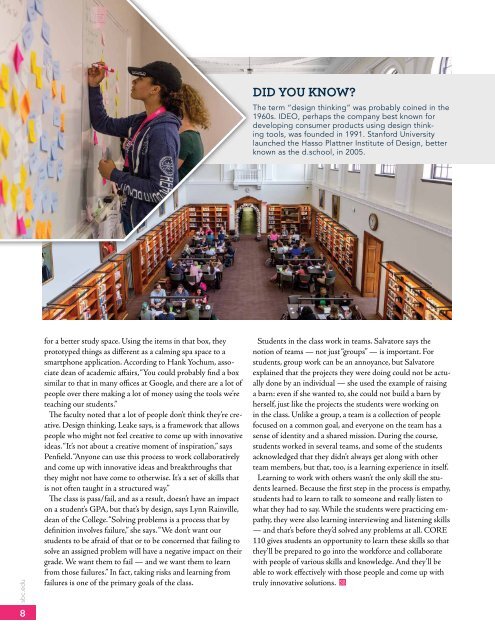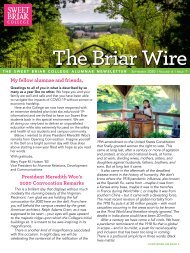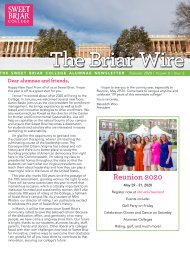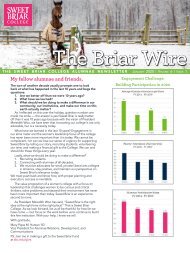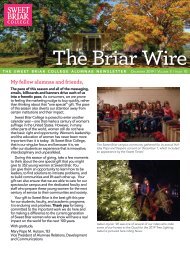Sweet Briar College Magazine - Fall 2018
You also want an ePaper? Increase the reach of your titles
YUMPU automatically turns print PDFs into web optimized ePapers that Google loves.
THE ARTS<br />
DID YOU KNOW?<br />
The term “design thinking” was probably coined in the<br />
1960s. IDEO, perhaps the company best known for<br />
developing consumer products using design thinking<br />
tools, was founded in 1991. Stanford University<br />
launched the Hasso Plattner Institute of Design, better<br />
known as the d.school, in 2005.<br />
sbc.edu<br />
for a better study space. Using the items in that box, they<br />
prototyped things as different as a calming spa space to a<br />
smartphone application. According to Hank Yochum, associate<br />
dean of academic affairs, “You could probably find a box<br />
similar to that in many offices at Google, and there are a lot of<br />
people over there making a lot of money using the tools we’re<br />
teaching our students.”<br />
The faculty noted that a lot of people don’t think they’re creative.<br />
Design thinking, Leake says, is a framework that allows<br />
people who might not feel creative to come up with innovative<br />
ideas. “It’s not about a creative moment of inspiration,” says<br />
Penfield. “Anyone can use this process to work collaboratively<br />
and come up with innovative ideas and breakthroughs that<br />
they might not have come to otherwise. It’s a set of skills that<br />
is not often taught in a structured way.”<br />
The class is pass/fail, and as a result, doesn’t have an impact<br />
on a student’s GPA, but that’s by design, says Lynn Rainville,<br />
dean of the <strong>College</strong>. “Solving problems is a process that by<br />
definition involves failure,” she says. “We don’t want our<br />
students to be afraid of that or to be concerned that failing to<br />
solve an assigned problem will have a negative impact on their<br />
grade. We want them to fail — and we want them to learn<br />
from those failures.” In fact, taking risks and learning from<br />
failures is one of the primary goals of the class.<br />
Students in the class work in teams. Salvatore says the<br />
notion of teams — not just “groups” — is important. For<br />
students, group work can be an annoyance, but Salvatore<br />
explained that the projects they were doing could not be actually<br />
done by an individual — she used the example of raising<br />
a barn: even if she wanted to, she could not build a barn by<br />
herself, just like the projects the students were working on<br />
in the class. Unlike a group, a team is a collection of people<br />
focused on a common goal, and everyone on the team has a<br />
sense of identity and a shared mission. During the course,<br />
students worked in several teams, and some of the students<br />
acknowledged that they didn’t always get along with other<br />
team members, but that, too, is a learning experience in itself.<br />
Learning to work with others wasn’t the only skill the students<br />
learned. Because the first step in the process is empathy,<br />
students had to learn to talk to someone and really listen to<br />
what they had to say. While the students were practicing empathy,<br />
they were also learning interviewing and listening skills<br />
— and that’s before they’d solved any problems at all. CORE<br />
110 gives students an opportunity to learn these skills so that<br />
they’ll be prepared to go into the workforce and collaborate<br />
with people of various skills and knowledge. And they’ll be<br />
able to work effectively with those people and come up with<br />
truly innovative solutions.<br />
8


